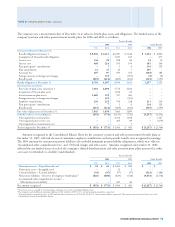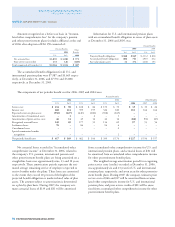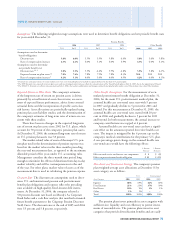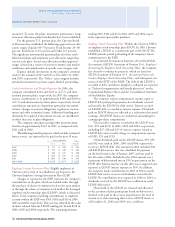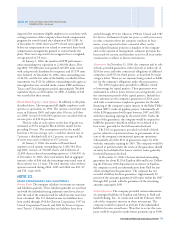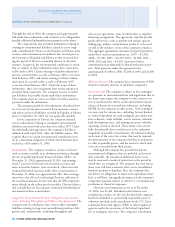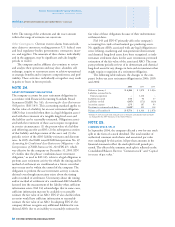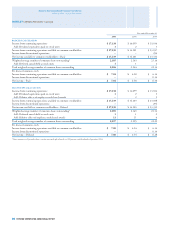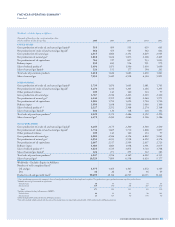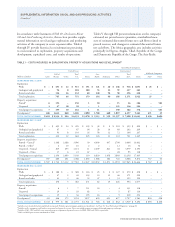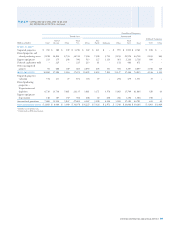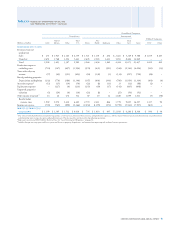Chevron 2006 Annual Report Download - page 83
Download and view the complete annual report
Please find page 83 of the 2006 Chevron annual report below. You can navigate through the pages in the report by either clicking on the pages listed below, or by using the keyword search tool below to find specific information within the annual report.
CHEVRON CORPORATION 2006 ANNUAL REPORT 81CHEVRON CORPORATION 2006 ANNUAL REPORT 81
reserve for these sites at year-end 2006 was $122. The federal
Superfund law and analogous state laws provide for joint
and several liability for all responsible parties. Any future
actions by the EPA or other regulatory agencies to require
Chevron to assume other potentially responsible parties’ costs
at designated hazardous waste sites are not expected to have a
material effect on the company’s consolidated fi nancial posi-
tion or liquidity.
Of the remaining year-end 2006 environmental reserves
balance of $1,319, $834 related to approximately 2,250 sites
for the company’s U.S. downstream operations, including
refi neries and other plants, marketing locations (i.e., service
stations and terminals) and pipelines. The remaining $485
was associated with various sites in the international down-
stream ($117), upstream ($252), chemicals ($61) and other
($55). Liabilities at all sites, whether operating, closed or
divested, were primarily associated with the company’s plans
and activities to remediate soil or groundwater contamination
or both. These and other activities include one or more of
the following: site assessment; soil excavation; offsite disposal
of contaminants; onsite containment, remediation and/or
extraction of petroleum hydrocarbon liquid and vapor from
soil; groundwater extraction and treatment; and monitoring
of the natural attenuation of the contaminants.
The company manages environmental liabilities under
specifi c sets of regulatory requirements, which in the United
States include the Resource Conservation and Recovery Act
and various state or local regulations. No single remediation
site at year-end 2006 had a recorded liability that was mate-
rial to the company’s fi nancial position, results of operations
or liquidity.
It is likely that the company will continue to incur
additional liabilities, beyond those recorded, for environ-
mental remediation relating to past operations. These
future costs are not fully determinable due to such factors
as the unknown magnitude of possible contamination, the
unknown timing and extent of the corrective actions that
may be required, the determination of the company’s liability
in proportion to other responsible parties, and the extent to
which such costs are recoverable from third parties.
Effective January 1, 2003, the company implemented
FASB Statement No. 143, Accounting for Asset Retirement Obli-
gations (FAS 143). Under FAS 143, the fair value of a liability
for an asset retirement obligation is recorded when there is a
legal obligation associated with the retirement of long-lived
assets and the liability can be reasonably estimated. The
liability balance of approximately $5,800 for asset retirement
obligations at year-end 2006 related primarily to upstream and
mining properties. Refer to Note 24 on page 82 for a discus-
sion of the company’s Asset Retirement Obligations.
For the company’s other ongoing operating assets, such
as refi neries and chemicals facilities, no provisions are made
for exit or cleanup costs that may be required when such
assets reach the end of their useful lives unless a decision to
sell or otherwise abandon the facility has been made, as the
indeterminate settlement dates for the asset retirements prevent
estimation of the fair value of the asset retirement obligation.
Global Operations Chevron and its affi liates conduct busi-
ness activities in approximately 180 countries. Besides the
United States, the company and its affi liates have signifi cant
operations in the following countries: Angola, Argentina,
Australia, Azerbaijan, Bangladesh, Brazil, Cambodia,
Canada, Chad, China, Colombia, Democratic Republic of
the Congo, Denmark, France, India, Indonesia, Kazakhstan,
Myanmar, the Netherlands, Nigeria, Norway, the Partitioned
Neutral Zone between Kuwait and Saudi Arabia, the Phil-
ippines, Republic of the Congo, Singapore, South Africa,
South Korea, Thailand, Trinidad and Tobago, the United
Kingdom, Venezuela and Vietnam.
The company’s operations, particularly exploration and
production, can be affected by changing economic, regulatory
and political environments in the various countries in which it
operates, including the United States. As has occurred in the
past, actions could be taken by governments to increase public
ownership of the company’s partially or wholly owned busi-
nesses or assets or to impose additional taxes or royalties on the
company’s operations or both.
In certain locations, governments have imposed restric-
tions, controls and taxes, and in others, political conditions
have existed that may threaten the safety of employees and
the company’s continued presence in those countries. Internal
unrest, acts of violence or strained relations between a govern-
ment and the company or other governments may affect the
company’s operations. Those developments have at times signi-
fi cantly affected the company’s related operations and results
and are carefully considered by management when evaluating
the level of current and future activity in such countries.
Equity Redetermination For oil and gas producing operations,
ownership agreements may provide for periodic reassess-
ments of equity interests in estimated crude oil and natural
gas reserves. These activities, individually or together, may
result in gains or losses that could be material to earnings in
any given period. One such equity redetermination process
has been under way since 1996 for Chevron’s interests in
four producing zones at the Naval Petroleum Reserve at Elk
Hills, California, for the time when the remaining inter-
ests in these zones were owned by the U.S. Department of
Energy. A wide range remains for a possible net settlement
amount for the four zones. For this range of settlement,
Chevron estimates its maximum possible net before-tax lia-
bility at approximately $200, and the possible maximum net
amount that could be owed to Chevron is estimated at about
NOTE 23. OTHER CONTINGENCIES AND COMMITMENTS – Continued




